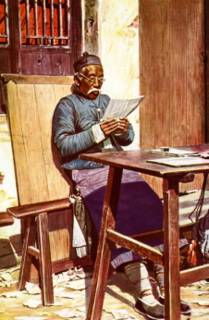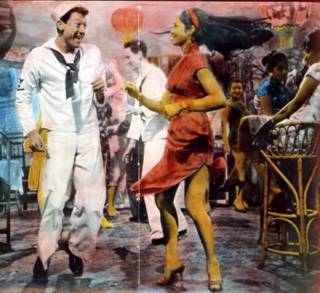
Old Chinese Postcard
National Geographic Adventure
Pelton's World
Cooking the Books
Five things travel guides never tell you.
Robert Young Pelton
I confess. I used to edit a travel guidebook series. The kind of books that said "eat here," "stay there," "visit this." I hired cool, funny people to boil down firsthand travel accounts into a few pithy pages, figuring that truly curious travelers would want to discover local gems in both the most touristed and most dangerous places. Well, I was wrong. The world didn't seem to want to be too far from the madding crowd—they wanted to know what time to get in line for the Louvre. The experience did, however, afford me the chance to compare, investigate, and become one of the world's greatest experts on the travel guide business. So from me to you, I will pass along the top five secrets, in no particular order, that guidebook publishers don't want you to know about their products.
1) THEY'RE OUTDATED.
It can take up to two years to get a book from drawing board to bookstore. If the guide clutched in your jet-lagged hands is "annually updated," I guarantee large chunks of its information were gathered long before the publication date. There's no way even a freshly published guide could address the current conditions in, say, Iraq in their latest editions. When looking for the most up-to-date, reliable safety information, I trust Google ("tourist + killed" usually does the trick).
2) THEY FUDGE THINGS.
Have you ever noticed how writers avoid telling you if they have actually been to a place or, if they have, how long ago? You can't expect a poorly paid guidebook writer with a three-month deadline to actually visit every listing in the book, especially if it's a guide to a country the size of Russia or Brazil. Whenever they start to use autopilot vocabulary to describe a standard budget hotel room—"cheap and cheerful," "cozy and comfortable"—chances are the writer has never seen the place.
3) THEY WEAR ROSE-COLORED GLASSES.
Developing countries need tourist dollars, but mass tourism needs a pretty face—even if the business bolsters some of the world's uglier inequities: underpaid labor and prostitution, to name just two. If a travel guide to Cancún or Thailand told you the whole truth about the impact tourism has had on the region's society, you probably wouldn't want to go, let alone buy the guidebook.
4) THEY KILL WHAT THEY LOVE.
Ever since Marco Polo came back from the East raving about the Gobi, travel guides have been sending battalions of tourists to destroy the world's treasured destinations. The "ant trails" carved by these hordes are usually infested with beach vendors (Goa), touts (the Great Pyramids), and thieves (take your pick)—not smiling locals wearing grass skirts or lederhosen. Attractions in popular guidebooks are never quite the idyllic places you imagine them to be. Even travel guide writers like Rick Steves can't book a room at some of their "off the beaten path" places anymore.
5) THEY WORK BEST IN COMBINATION.
No single guide has it all. I will say, however, that Lonely Planet provides some excellent city maps, Rough Guides have great cultural backgrounders, Michelin Red knows where to get a good meal, and if you like ancient monuments the Blue Guides rule. I'll even give a big thumbs up to the Trailblazer series. But most of this stuff can be scrawled into a notebook at the library and added to the up-to-date info you've culled from the Web. As for me, yeah, I still write guidebooks—but they skip hotels, restaurants, tours, and attractions. Ask the locals where to go and what to do. Travel is still an adventure, after all. That's something that the guidebooks seem to forget.
10 Better Choices
Tired of clinging to that guidebook like it's a security blanket? Try reading something that tells you how to appreciate the art of travel rather than how to spend money. Here are ten insightful travelogues that will inspire rather than dictate.
The Beach, by Alex Garland
First-Time Around the World, by Doug Lansky
Globetrotter Dogma, by Bruce Northam
Personal Narrative of a Pilgrimage to Al Madinah and Mecca, by Sir Richard Francis Burton
The Practical Nomad, by Edward Hasbrouck
Traveler's Handbook, edited by Amy Sohanpaul
The Traveler's Tool Kit, by Rob Sangster
Travels in Asia and Africa 1325-1354, by Ibn Battuta
The Travels of Marco Polo, by Marco Polo
Vagabonding, by Rolf Potts
National Geographic Adventure Column by Robert Young Pelton on Travel Guidebooks


